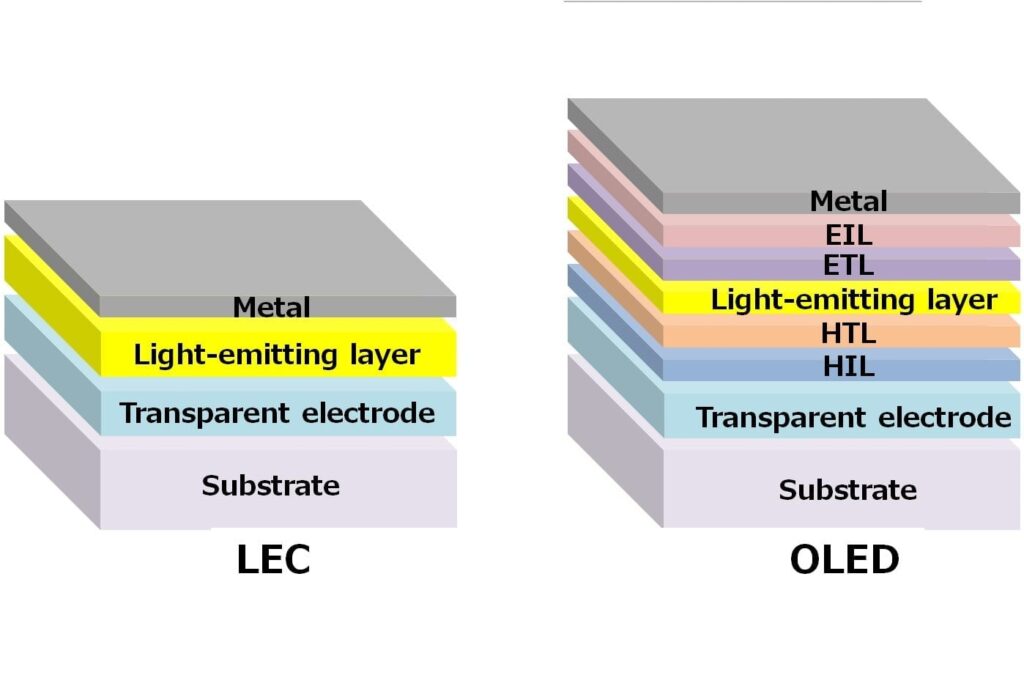
Researchers from Umeå University and Linköping University in Sweden have developed light-emitting electrochemical cells (LECs) that emit strong light at high efficiency. As such, the thin, flexible and light-weight LEC promises future and improved applications within home diagnostics, signage, illumination and healthcare.
The results are published in Nature Communications.
The light-emitting electrochemical cell (LEC) can be thin, flexible, and light-weight and be driven to essentially any emission color by the low voltage of a battery. It can also be extremely low cost, since it can be fabricated with low-cost printing and coating methods similar to how newspapers are fabricated.
So far, a persistent and problematic drawback has been that it has not been possible to attain strong brightness at high efficiency from LEC devices. In fact, it has been questioned on general grounds whether the LEC is even capable of being simultaneously bright and efficient.
In the current issue of Nature Communications, a team of scientists from Umeå University, Linköping University and the company LunaLEC AB in Sweden demonstrate a path towards resolving this problem. Using a systematic combination of experiments and simulations, they have established a generic set of design principles, including balanced trap depths, optimized doping, and electrochemically stabile materials. The researchers’ approach has paved the way for LEC devices that emit light with a high brightness of 2,000 cd/m2 at an electron-to-photon efficiency of 27.5 percent. “As a point of reference, a normal TV operates between 300 to 500 cd/m2, while 2,000 cd/m2 is the typical brightness of an OLED illumination panel. Concerning efficiency, our LEC device is close to that of common fluorescent tubes”, says Ludvig Edman, leader of the project and professor at the department of physics at Umeå University.
What future do you see for LEC components?
“With this performance, the LEC component is now not only offering low costs and highly attractive design advantages, but is also becoming a true competitor with existing technologies, such as the fluorescent tube, LED and OLED, as regards to efficient and practical operation”, says Martijn Kemerink, professor at the department of physics, chemistry and biology at Linköping University.
Learn more: The LEC: Now an efficient and bright device
The Latest on: Light-emitting electrochemical cells
[google_news title=”” keyword=”light-emitting electrochemical cells” num_posts=”10″ blurb_length=”0″ show_thumb=”left”]- Development of ultra-high-efficiency pure red light-emitting devices with enhanced color representationon May 8, 2024 at 6:38 am
Perovskite emitters, commonly used in solar cells and light-emitting devices, are gaining attention as next-generation optoelectronic materials owing to their cost-effectiveness and efficient ...
- Light Emitting Diode-Based Therapyon May 4, 2024 at 5:00 pm
It delivers pulsed visible yellow light (588 nm ± 10 nm) from two contiguous LED panels. It is claimed to "energize" mitochondria, send cell signals to cell receptors, increase/decrease gene ...
- New understanding of energy losses in emerging light sourceon April 20, 2024 at 12:04 am
More information: Xiaoying Zhang et al, Efficiency Roll‐Off in Light‐Emitting Electrochemical Cells, Advanced Materials (2024). DOI: 10.1002/adma.202310156 Provided by Umea University ...
- New understanding of energy losses in emerging light sourceon April 18, 2024 at 4:08 am
The light-emitting electrochemical cell (LEC) can be fabricated in a sustainable and cost-effective way on both rigid and flexible surfaces making it suitable for a broad range of applications ...
- New understanding of energy losses in emerging light sourceon April 17, 2024 at 5:00 pm
(Nanowerk News) The light-emitting electrochemical cell (LEC) can be fabricated in a sustainable and cost-effective way on both rigid and flexible surfaces making it suitable for a broad range of ...
- Shaping Cells With Lighton April 7, 2024 at 5:00 pm
Imagine switching on a light and being able to understand and control the inner dynamics of a cell. This is what the Dimova group has achieved: by shining lights of different colors on replicates of ...
- Conjugated Polymers for Organic Electronicson March 27, 2024 at 5:01 pm
The use of emissive polymers in devices such as light-emitting electrochemical cells, chemiluminescence cells and light-emitting transistors is described and the different design features needed to ...
- Operating mechanism of light-emitting electrochemical cellson January 21, 2024 at 4:34 am
The comments by Pei and Heeger on our paper published in Nature Materials 1 call for a clarification of the mechanism of the operation of light-emitting electrochemical cells (LEECs). The simplest ...
- Winner: 2022 Dalton Division Horizon Prizeon June 8, 2022 at 10:49 am
A team of scientists from across Europe have devised a multidisciplinary approach blending chemistry, engineering and maths to create blue and white copper (l) complex light-emitting electrochemical ...
- Operating mechanism of light-emitting electrochemical cellson February 17, 2019 at 2:31 pm
Figure 1: Optical microphotograph of the Au/polymer admixture/Au LEC (surface cell configuration) during operation at 4-V bias. The formation of a p–i–n light-emitting junction was proposed ...
via Google News and Bing News










